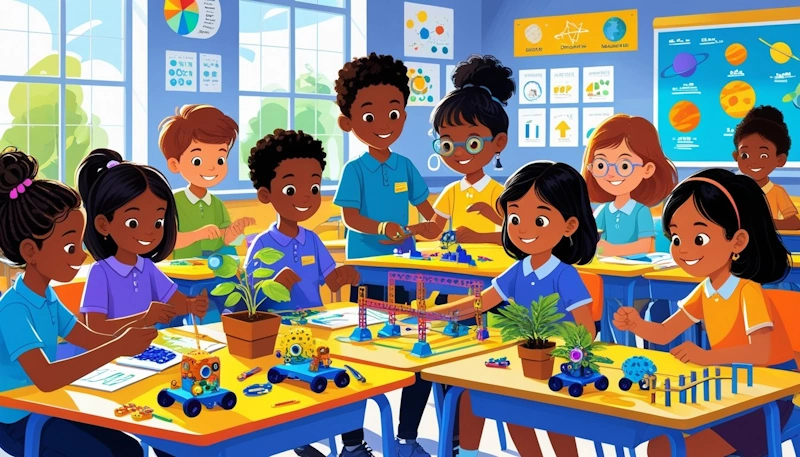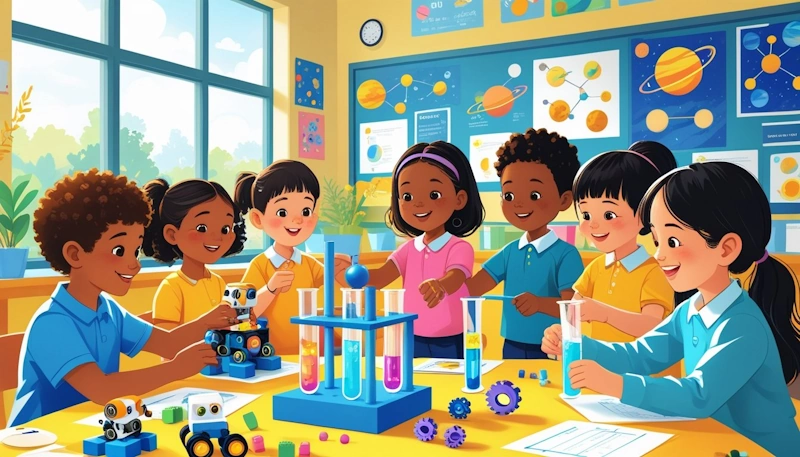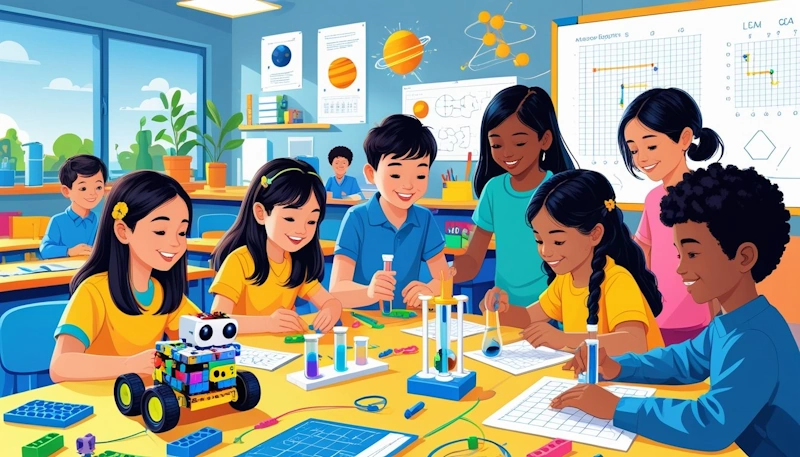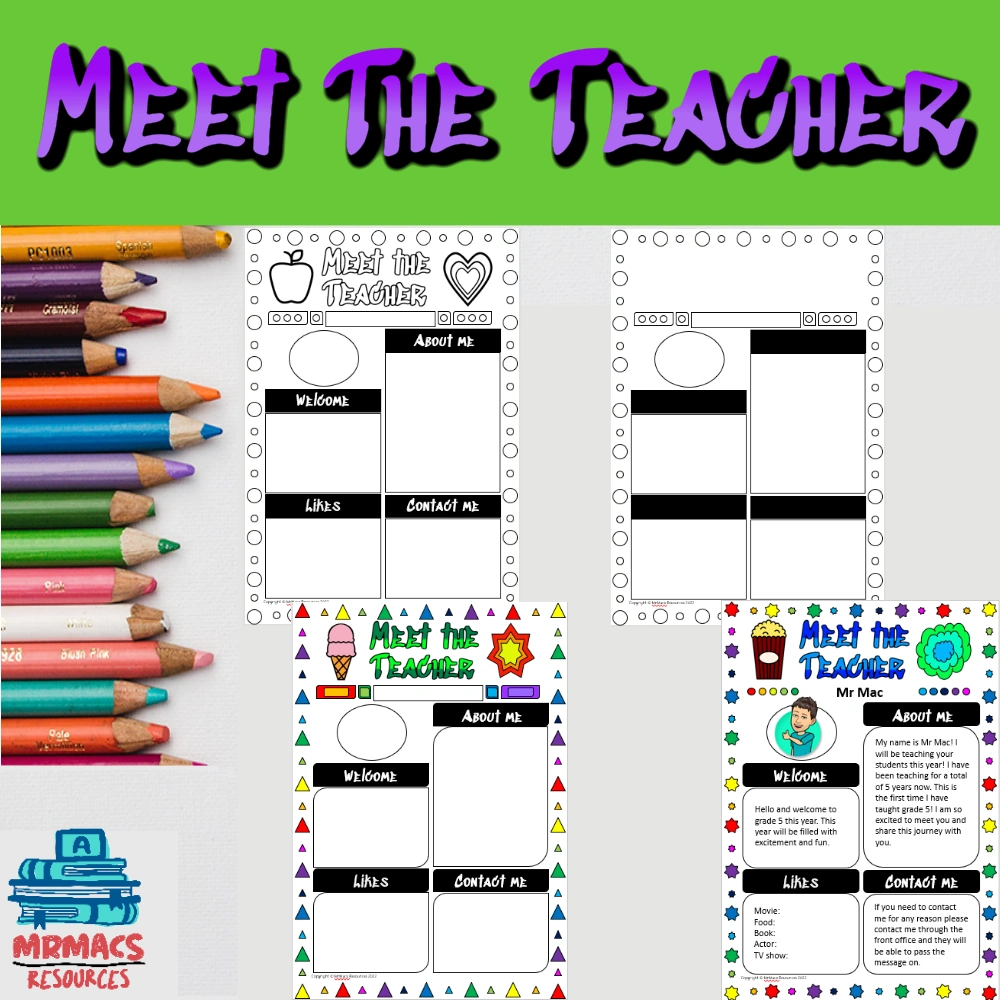
Primary school students naturally love hands-on learning, and STEM activities provide the perfect opportunity to spark their curiosity whilst building critical thinking skills. These engaging activities combine science, technology, engineering, and mathematics in ways that make complex concepts accessible and fun for young learners. Moreover, from building structures with everyday materials to conducting simple experiments, STEM education helps students develop problem-solving abilities they’ll use throughout their lives.
What’s more, the key to successful STEM activities lies in choosing projects that match your students’ developmental stage whilst encouraging exploration and discovery. Simple activities like creating parachutes to test air resistance or building towers with marshmallows can teach fundamental engineering principles without overwhelming young minds. Additionally, these activities work brilliantly because they connect abstract concepts to real-world applications that students can see and touch.
Ultimately, when you integrate different STEM disciplines into your teaching, you create opportunities for students to see how these subjects work together in everyday life. The most effective activities encourage students to ask questions, make predictions, and learn from both successes and failures. In addition, this approach builds confidence and helps students develop a positive relationship with STEM subjects that can last a lifetime.
Fundamental Concepts in STEM for Young Learners

STEM education combines science, technology, engineering, and mathematics to create meaningful learning experiences that build essential skills. These activities help children develop critical thinking abilities while exploring real-world problems through hands-on experiments and creative projects.
What is STEM Education?
STEM education brings together four key subjects into one connected learning approach.
Firstly, science helps students understand the natural world around them.
Secondly, technology shows how tools and digital systems work in everyday life.
Thirdly, engineering teaches students how to design and build solutions to problems.
Fourthly, mathematics provides the foundation for measuring, calculating, and understanding patterns. When these subjects work together, they create powerful learning experiences.
The goal is to help students see how these subjects connect in real life. For example, building a bridge uses engineering design, mathematical calculations, scientific principles, and sometimes technology tools. What’s more, this approach makes learning more meaningful and engaging for young minds.
STEM learning encourages students to ask questions and explore answers through experiments. Children learn to test ideas, make observations, and draw conclusions. This process mirrors how scientists and engineers work in the real world.
Importance of Hands-On STEM Activities
Hands-on STEM activities engage multiple senses and help children understand abstract concepts. When students touch, build, and experiment, they remember lessons better than just reading about them. These activities make learning fun and memorable.
In addition, young learners develop confidence through practical experiences. For instance, building a tower with jellybeans or creating a cloud in a jar gives students immediate feedback. They can see what works and what doesn’t work right away.
Moreover, these activities also encourage creativity and innovation. Students find different ways to solve the same problem. One child might build a tall thin tower while another creates a wide stable base. Both approaches teach valuable lessons about engineering and design.
Key benefits of hands-on learning include:
- Better retention of information
- Increased engagement and motivation
- Development of fine motor skills
- Understanding of cause and effect relationships
In addition, young learners develop confidence through practical experiences. For instance, building a tower with jellybeans or creating a cloud in a jar gives students immediate feedback. They can see what works and what doesn’t work right away.
Moreover, these activities also encourage creativity and innovation. Students find different ways to solve the same problem. One child might build a tall thin tower while another creates a wide stable base. Both approaches teach valuable lessons about engineering and design.
Key Developing Critical Thinking and Problem-Solving Skillsof hands-on learning include:
STEM activities naturally develop critical thinking skills through inquiry-based learning. Students learn to observe carefully, ask good questions, and make predictions. Ultimately, they test their ideas and analyse the results to understand what happened.
Problem-solving skills grow as students face challenges in their projects. When a parachute doesn’t work properly, children must figure out why and try again. This process teaches persistence and logical thinking.
Also, students learn to break big problems into smaller parts. Building a balloon-powered car requires understanding motion, designing the body, and testing different materials. Each step involves careful thinking and planning.
Likewise, these skills transfer to other subjects and real-life situations. Children who practice problem-solving in STEM activities become better at solving maths problems and handling everyday challenges. They learn to think before acting and consider multiple solutions.
Popular and Engaging STEM Activities
These classic STEM challenges help students develop problem-solving skills whilst exploring engineering and science concepts. What is more, each activity encourages students to think like engineers and scientists through hands-on experiments.
Egg Drop Challenge
The egg drop challenge teaches students about engineering design and physics principles. Students must design and build a protective container that will keep a raw egg safe when dropped from a height.
Materials needed:
- Raw eggs
- Cardboard boxes
- Bubble wrap
- Cotton balls
- Tape and scissors
- Straws or craft sticks
To begin, have students drop their containers from a chair height. Then gradually increase the height to test their designs. This activity demonstrates concepts like gravity, impact force, and shock absorption.
Also, students learn to follow the engineering design process by planning, building, testing, and improving their designs. Many students discover that adding padding or creating crumple zones helps protect the egg. While others find that parachutes or wing designs can slow the fall.
Key learning outcomes:
- Problem-solving skills
- Understanding of physics concepts
- Engineering design thinking
- Trial and error methodology
STEM Activities - Building a Water Filtration System
Creating a water filtration system teaches students about environmental science and engineering solutions. Therefore, students design filters to clean dirty water using common materials found around the classroom.
Basic filter materials:
- Plastic bottles
- Coffee filters
- Sand and gravel
- Cotton balls
- Activated charcoal (optional)
Firstly, students begin by observing how different materials trap particles and clean water. Then, they layer materials in bottles to create multi-stage filtration systems. This hands-on STEM activity shows how real water treatment plants work.
The activity connects to environmental issues like clean water access. Students see how engineering solutions can solve real-world problems. Additionally, they test their filters with muddy water or water mixed with food colouring.
Educational benefits:
- Environmental awareness
- Engineering problem-solving
- Scientific observation skills
- Understanding of filtration processes
Bridge Building Challenge
The bridge building challenge combines engineering principles with creative problem-solving. Students design and construct bridges using limited materials whilst trying to support the most weight possible.
Common materials:
- Wooden craft sticks
- Glue or tape
- String
- Cardboard pieces
- Testing weights (books or small objects)
Students learn about structural engineering concepts like tension, compression, and load distribution. For instance, they discover that triangular shapes often create stronger structures than rectangles. This STEM challenge encourages students to think about real bridges they see in their communities.
What is more, you can introduce different bridge types like beam bridges, arch bridges, or suspension bridges. Students test their designs by gradually adding weight until the bridge fails. This testing phase teaches them about engineering limits and safety factors.
To conclude, the activity demonstrates how engineers must balance strength, cost, and available materials. Students often rebuild their bridges multiple times, learning from each failure and improving their designs.
Integrating Different STEM Disciplines in Activities

Effective STEM learning happens when students connect science, technology, engineering, and mathematics through hands-on projects. These integrated activities help children see how different subjects work together to solve real-world problems.
STEM Activities - Coding and Computational Thinking Projects
Coding projects offer primary school students a practical way to combine technology with problem-solving skills. Students can use simple platforms like Scratch to create interactive stories that teach maths concepts.
Also, building LEGO mazes with coding elements helps children understand basic programming whilst developing engineering skills. They learn to break down complex problems into smaller steps.
Popular coding activities include:
- Creating digital animations that show science concepts
- Programming simple games that require maths calculations
- Building robots that move through obstacle courses
- Designing interactive quizzes about different subjects
These projects teach students to think logically and systematically. Moreover, they learn to test their ideas and make improvements when something doesn’t work properly.
Exploring Solar Panels and Renewable Energy
Solar panel projects connect science learning with environmental awareness and engineering design. Students can build simple solar ovens using cardboard boxes and reflective materials.
These activities teach children about energy conversion and heat transfer. They also learn about sustainable technology and its importance for our planet.
Effective solar energy projects:
- Building solar-powered cars using small motors
- Creating solar ovens to cook simple foods
- Testing different materials for energy efficiency
- Designing solar panel systems for model houses
Students discover how sunlight transforms into usable energy. Additionally, they explore how engineers design systems to capture and use renewable energy sources.
Incorporating Arts into STEM (STEAM)
Adding arts to STEM activities creates engaging experiences that appeal to different learning styles. Crystal sun catchers combine chemistry concepts with artistic design and creativity.
Furthermore, students learn about crystal formation whilst creating beautiful decorations. This approach helps children understand scientific processes through visual and tactile experiences.
STEAM activities that work well:
- Designing bridges that are both strong and visually appealing
- Creating stop-motion videos to explain scientific concepts
- Building musical instruments to explore sound waves
- Making colourful slime to study chemical reactions
These projects show students that science and art complement each other. Furthermore, they develop both analytical thinking and creative expression skills simultaneously.
Conclusion
In conclusion, incorporating engaging STEM activities into primary school education not only fosters hands-on learning but also encourages critical thinking and problem-solving skills.
Furthermore, these activities provide students with meaningful challenges that spark curiosity and creativity.
Ultimately, by integrating such interactive experiences, educators can inspire a lifelong passion for science, technology, engineering, and mathematics.
Therefore, embracing hands-on STEM learning is essential for preparing young learners to thrive in an ever-evolving world.
What are your favourite hands-on STEM activities to engage primary school students and spark their curiosity through meaningful challenges?
About The Author

Hi! My name is Mr Mac. I am a K – 6 teacher. I love to create resources for teachers to make their teaching lives easier.



